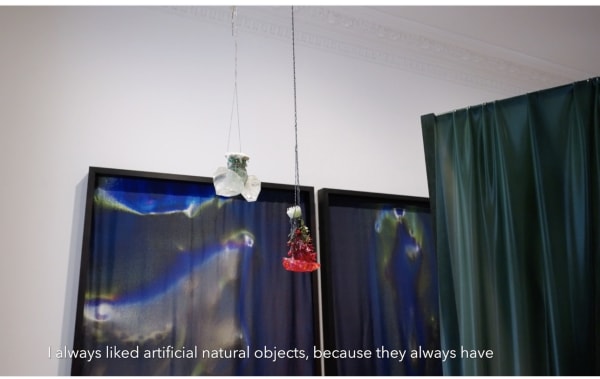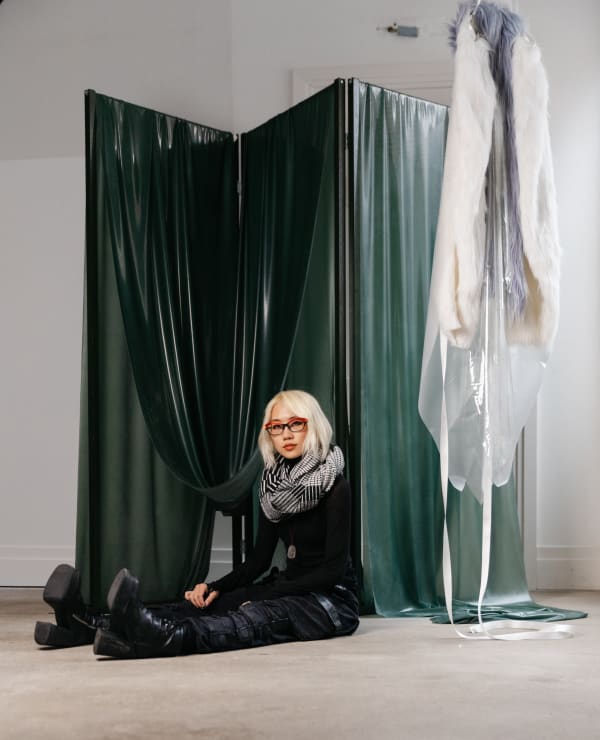ai. is pleased to present a solo exhibition by artist WeiXin Quek Chong (b.1988, Singapore / living in Madrid) titled deepdreams_sublimed. This is the first solo exhibition with the gallery.
Chong brings together sculpture, video, print as well as installation exploring the theme of tactility through sound and material with underlying references to historical & cultural figures and elements. From an interest in dichotomies between digital \ organic, monumental \ minuscule and other constructed binaries, her artistic concerns have expanded into exploring ways value systems and social interfaces are expressed and evolve, often alluded to and grounded in visual and material forms.
- - -
About the artist
Chong (b.1988, Singapore) currently lives & works in Madrid. She completed her BA at LaSalle College of Arts, Singapore (2010) and her MFA at Royal College of Arts, London (2014). She was awarded the President's Young Talents Award 2018 by Singapore Art Museum (1 of 5 artists aged under 35 years) and the 2019 Singapore National Arts Council Young Artist Award. She was an artist in residency at National Museum of Modern & Contemporary Art, Seoul (2019), Museo de Arte Contemporaneo Santiago, Chile (2017). She has exhibited internationally including Gerdasafn Museum, Reyjkavik (2021), Tainan Art Centre, Taiwan (2019), Institute of Contemporary Arts, Singapore (2019), Singapore Art Museum (2018) and NTU CCA Singapore (2017).
- - -
About the curator
Anca Rujoiu (b. 1984, Bucharest/living in Singapore) is a curator, editor, and PhD candidate at Monash University. As curator for exhibitions and later head of publications (2013-2018), she was part of the founding team of the NTU Centre for Contemporary Art Singapore. In 2019, she was the co-curator of the third edition of the Art Encounters Biennial, Timișoara, approached as a one-year institutional programme.
Exhibition text written by Anca Rujoiu
Have you ever watched a mantis? Sss...Wait. She will break the disguise, sway the head back, and push the body forward through that extraordinary choreography of her bent forelimbs that draw fascination and fear. She will stop and wait patiently in ambush, immobile yet alert.
There are no mantises per se in this solo exhibition by Weixin Quek Chong. There are, we could say, mantis overtones that permeate through the artworks. In the past years, Chong translated the complex dynamics between subordination and domination in artworks that deepen the experience and imagination of touch. Chong deploys products and practices conventionally associated with fetish or "kink"- latex, buttplugs, vacuum bondage, among others- as materials and techniques in art-making and sources of aesthetic experience.
In Chong's tightly framed and shot videos, latex operates as a screen. Elongated limbs sealed in vacuum are endowed with agency: feet and arms touch and stretch gently the latex material creating folds and swellings that visibly articulate their presence. Drawing references to cultural histories of bonding and women's painful experiences, such as corset-wearing and foot-binding, Chong sees in body modifications a practice that disputes the entrenched distinctions between the natural and the artificial.
In a series of prints, the cultural and erotic practice of bondage becomes an innovative method for image-making. The images came into being through the scanning of orchids compressed in vacuum bondage. This ubiquitous and mysterious plant that largely lives in the tropics has featured so much in the Western imaginary that become inseparable of sensuous associations. The orchid is an exemplary case study where botanical knowledge intersects with printing developments, women's histories and nation-building efforts. At the cross-road of so many forces and imaginaries, no wonder that decontextualised and abstracted, compressed by the vacuum, the orchid struggles to breathe.
Suspended from the ceiling by fabric or metal, made out of silicone, glass and faux-fur, Chong's sculptural objects are hybrid entities. The works borrow as much from surrealist visual language as from fashion, and what the artist perceives as "resistive literature," bodies of writings cutting through gender, race, class, and genres. Some sculptures, displaying a three-part body and curved shapes are inspired by tropical mantises, in particular, those who have a capacity for transformation. Able to mimic parts of the orchid anatomy, such mantises can morph into plants. Looking precious and soft, with visible textures and a mix of materials, lying dormant above the ground, the sculptures allude to a tactile experience and imaginary as another source of the sublime.










